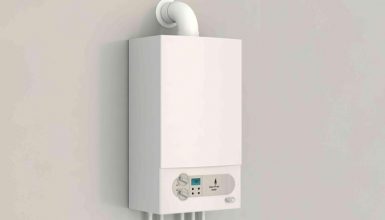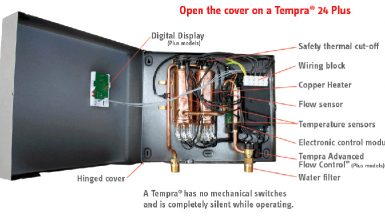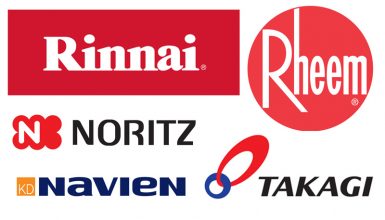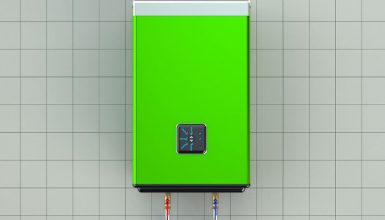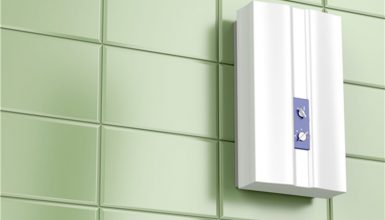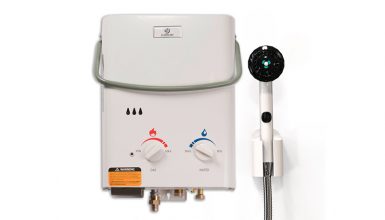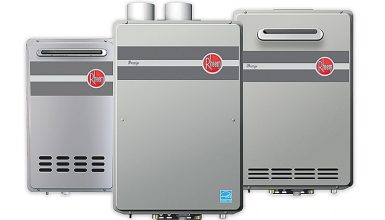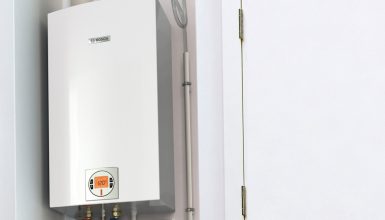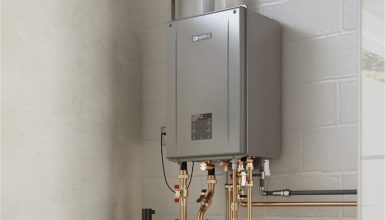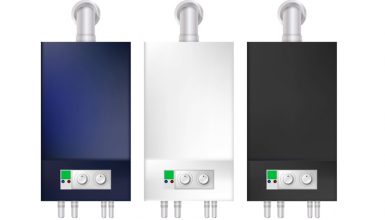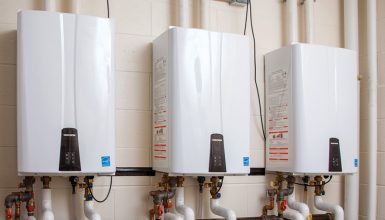You’ve probably come across this article because you’re shopping around for replacement water heaters. We guess you’ve got 1001 questions about the Rinnai, their reputation, and most importantly – their products.
Well, you can stop looking because you’ve just found the most comprehensive guide to Rinnai tankless water heaters on the entire internet.
We recommend you grab a drink and get comfy because this is going to be a long one…
Let’s get started.
Rinnai Tankless Water Heater Reviews
1. Rinnai RU Series Sensei SE+ 11 GPM Propane Tankless Water Heater

This tankless water heater from Rinnai is capable of outputting 11 GPM. Hence, it’s perfectly capable of handling the demands of a small to medium-sized family.
The thing that makes this unit unique is the Circ-Logic technology. It’s an innovation that monitors the habits of the house in relation to the demands of hot water. Thus, it can increase and decrease the flow rate following the typical habits of the users. In the end, it can help you save even more money as the system knows how to adjust itself.
The warranty for this unit is also thorough. It comes with a 120 months warranty on the heat exchanger, 12 months for labor, and 60 months for parts. When comparing it to other units, the warranty in this one is very satisfactory.
It’s also a very reliable unit as the average lifespan is about 20 years. Furthermore, all of the components are replaceable. In other words, if the unit breaks down, you can always find a replacement part, and that will save you money from buying a new unit.
There’s not a lot of downside to this unit as it’s well-designed and reliable. However, if you want to be nitpicky, then you can say that it can only be powered by propane, which is not available in every part of the country.
Pros
- Wi-Fi Ready
- 11 GPM hot water flow rate
- Circ-Logic technology
- All parts are replaceable
Cons
- The unit can only be powered by propane
2. Rinnai RUC Series 9.8 GPM Natural Gas Tankless Water Heater

This unit comes with condensing technology. It’s a bit tricky to explain what it is without making it complicated. All you really need to know is that it recycles some of the energy spent in heating the water. As a result, it’s a unit that’s even more efficient compared to the previous generations. It’s also the reason why it has a high energy factor. To be specific, the unit boasts a 0.96 Energy Factor and 0.92 Universal Energy Factor.
The unit can also be powered by propane or natural gas. This is something that’s very advantageous as most units will only use propane or natural gas, but rarely both. With this unit, your options are limited. You can then choose a fuel that’s cheaper to get more savings.
The unit is space-saving. Hence, it’s an excellent choice if you don’t have a lot of room to work with. The size is similar to a small-sized suitcase. You’ll have little concerns about whether the unit will fit or not. Another thing that’s worth mentioning about this unit is that it comes with ultra-low emission. “How low?” you may ask. Well, it’s almost non-existent.
The unit does have a bit of a downside. It can only be used for indoor installation. However, it’s not a deal-breaker as most residential tankless water heater systems are designed for indoor use only.
Pros
- Condensing technology
- High energy factor
- Ultra-low emissions
- 199,000 max BTU
Cons
- Wi-Fi technology not enable
3. Rinnai RL Series HE+ 9.4 GPM Propane Tankless Water Heater

This unit is capable of outputting 9.4 GPM. It’s not the highest GPM on our list, but it’s also not the lowest. It’s sitting right in the middle. It should be able to handle up to a medium-sized family only if the hot water demand isn’t on the high end.
The unit also comes with Rinnai’s Circ-Logic technology, which aims at improving efficiency even more. In fact, the system can achieve up to 40% efficiency compared to a water heater with tank.
The real attractive feature of this unit is the size. It’s very compact. Because of its small size, you’ll be able to install this system in non-traditional places. A couple of examples are crawl space and attic. It’s even small enough to fit into a large closet.
The reliability is also top-notch. You can expect the system to last at least 20 years. When compared to the old traditional tank heater system, you are doubling the average lifespan. Of course, this equates to more savings. Add the fact that all of the parts in the unit’s system can be replaced, then you’ll also have the peace of mind that you won’t be spending a fortune for hot water any time soon.
On the downside, the system can only make use of propane for fuel. Although propane is generally cheaper than electricity, it’s not available in all areas.
Pros
- Circ-logic technology
- Small and compact
- Very reliable
- Great factory warranty
- 9.4 GPM hot water flow rate
Cons
- Propane only
4. Rinnai V Series HE 7.5 GPM Natural Gas Tankless Water Heater

One of the most attractive features of this unit is you’ll be able to connect to it via an app. In other words, as long as you have an Internet connection, you’ll be able to control this tankless water heater. You could be on vacation, and there’s no need to worry if you have turned off the system as you can do that remotely.
It has an accompanying app called Control-R 2.0. You can download the app, and then you can control the system. The app also has other useful features, such as timers and scheduling. If you take the time to learn about its features, you can then further increase your energy bill savings by optimizing its use.
The warranty is also worth mentioning as it’s very competitive. For the heat exchanger, you can expect a 120-month warranty. Also, 12 months for labor and 60 months for the parts.
Since you’ll be purchasing a Rinnai product, then you can expect top-of-the-line reliability. You can expect 20 years of average use, and all parts are replaceable.
The system is well designed, and that means downsides are not so many. Perhaps, you could say that the GPM is only 7.5. However, you should be calculating your estimated flow rate demand before you even start shopping for a tankless water heater. Hence, if 7.5 GPM is not sufficient, then you need to look elsewhere.
Pros
- Reliable
- Wi-Fi Ready
- Control-R 2.0 app
- Leak detection
- Residential factory warranty
Cons
- The unit’s flow rate output is a bit low
5. Rinnai V Series HE 6.5 GPM Propane Tankless Water Heater

Here is another product from Rinnai that has Wi-Fi connectivity. It can also be controlled by the app known as Control-R 2.0. It’s a nice feature to have as “smart appliance” is a trend of the future. Aside from that, it can also help you save money by making use of the timers and schedulers to optimize the use of the system.
Since you’ll be purchasing a Rinnai product, you can expect a very competitive warranty. For the heat exchanger, it comes with a 12-month warranty. For labor and parts, 12 months and 60 months respectively.
Another thing that’s worth mentioning is that the system is approved by the South Coast Air Quality Management District. That means that the system will not affect the air quality of the home. This seal of approval is crucial as most tankless water heaters are made for indoor installation. Thus, you’d want something that won’t negatively affect the air quality to avoid health problems in the future.
While this unit has excellent features, it has a glaring downside. Its flow rate is only 6.5 GPM. In fact, it’s the least when compared to other units on this list. However, it’s still powerful enough to power five fixtures at once just as long the total flow rate is below 6.5 GPM.
Pros
- Quiet
- Wi-Fi Ready
- Control-R 2.0
- Approved by the South Coast Air Quality Management District
- Certified for Installation in Manufactured/Mobile Homes
Cons
- The unit’s flow rate output is a bit low
How to Choose the Best Rinnai Tankless Water Heater
Tankless water heating systems are getting more and more popular. The reason for this is because they are a lot more efficient compared to the water heaters with tanks. In most cases, you can expect an increase in efficiency by as much as 40%.
- Efficiency
One of the reasons why users switch to a tankless water heating system is because it’s more efficient, and that means saving money on energy bills. Hence, it’s one of the factors that you should remember when shopping for a tankless water heater.
Keep in mind that as the household demand for hot water increases, the savings and efficiency will decrease. Having said that, a tankless water heating system will still be cheaper compared to the traditional storage tank heating systems.
The beauty of shopping for a tankless water heating system is that it’s easy to know the efficiency. The reason for this is because the units are rated using the Energy Factor (EF). And yes, it’s also the same rating system that’s used in other appliances.
Calculating for the EF can be boring and complicated. The only thing that you really need to know is that the higher the EF, the more efficient the unit.
Keep in mind that the EF rating doesn’t paint a complete picture. It only calculates the energy consumed and the hot water output. The thing is, gas energy is typically less expensive than electric energy. Hence, you should keep this in mind when comparing EF between units.
- Warranty
Warranty is a big factor that most people tend to ignore. Most people are interested in the feature and price. However, if the unit breaks down for some reason, then the warranty will play a big part in keeping the cost down.
It’s one of the many reasons why you should take into consideration the warranty when comparing products. Keep in mind that warranties are different from model to model and manufacturer to manufacturer. Hence, don’t assume that since the two units are made from the same manufacturer, the warranties will be the same.
Warranty is also another indicator of how much the manufacturer is confident with the reliability of their product. After all, if a manufacturer doesn’t believe a specific unit will last very long, they won’t offer a good warranty. Otherwise, they’d stand to lose more money if the reliability is poor.
Generally, when it comes to the tankless water heater, a 10 to 15 years warranty is good. For parts, it should be around 2 to 5 years. Labor is around 1 year.
- Size
If you want the best value for the money, then you should pick the right size for your tankless water heater. If it’s too big for the household demand, then you are wasting money. If it’s too small, then it can’t cope with the requirements of the house.
When sizing a storage tank water heater, the capacity is the most important thing. However, the flow rate is the most crucial factor for the tankless water system as it doesn’t have a tank.
Keep in mind that since it doesn’t have a tank, the system should be able to keep up with the demand during peak usage. Determining the right flow is not exactly effortless, but it’s crucial that you do it.
Below are the steps you should take:
- 1. Calculate the flow rate demand of the house at its peak
The most common use for hot water is for the shower, bathroom faucet, and kitchen faucet. Hence, imagine that it’s the peak usage for the house. On average, a 1992 standard showerhead will use 2.2 GPM while the older ones will consume 4 – 8 GPM. A 1992 bathroom faucet will use 2.2 GPM while the older ones will use 3 – 5 GPM. For kitchen faucets, the 1992 standard will use 2.2 GPM, while the older ones will use 3 – 7 GPM.
During the peak usage, calculate how many showers and faucets are running at the same time. Add them all together to get the peak flow rate of your house. Also, don’t forget about other appliances that use hot water, such as the dishwasher and washing machine — assuming that they are running together with the showers and faucets during peak time.
- 2. Calculate the needed temperature rise
Since the unit needs to heat the water, you will also need the heating capabilities of the unit. To calculate the needed temperature rise, you will first need to determine the water temperature while it’s in the pipes. After you get the number, subtract it to the desired temperature to get the temperature rise capacity.
Also, keep in mind that the temperature in the pipes never stays the same throughout the year. Hence, it’s best that you use the average water pipe temperature during the winter. If you really want to be sure, then determine the lowest water pipe temperature during wintertime.
- 3. Select the unit that can accommodate the needs of the house
Now that you know the GPM and the temperature rise needed, you can then combine the two to find the right unit for you.
For example, if you want the output temperature to be at 110 degrees Fahrenheit and the water pipe temperature is at 50 degrees Fahrenheit, then you need a unit that’s capable of a 60-degree Fahrenheit rise.
Then, if you have determined that the house uses 15 GPM at its peak, then you can combine the two factors to get the ideal unit for you. In our example, you are looking for a unit that’s capable of 15 GPM with a 60-degree Fahrenheit rise.
- Fuel Type
You can’t heat water if you don’t have an energy source. The most common options are electricity, natural gas, or propane. In most cases, you will have to settle with the fuel type that’s available in your area. If you are one of the lucky ones that have access to electricity or gas, then you will have a choice to make.
An electric tankless water heater is cheaper to install and maintain. On the downside, your operational cost will be higher as electricity is generally more expensive than gas.
On the other hand, a gas tankless water heater is expensive to install and maintain. On the upside, natural gas is generally cheaper than electricity.
Because of the pros and cons of the two, it’s generally up to you to find out what’s the better one for you. Perhaps, you could say that if you are planning to stay in the house for a very long time, then a natural gas tankless water heater may be the better option. The reason for this is because the most significant factor, in the long run, is the operational cost and not the cost of installation and servicing.
Rinnai Tankless Water Heater Comparison


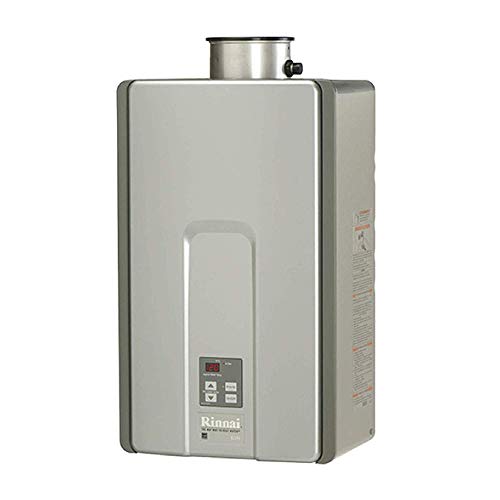







Conclusion
The essential factor for finding the right Rinnai water heater for you is the flow rate, which is measured in Gallons per Minute or GPM. With the other key points mentioned in the buying guide, you should be able to narrow down your options.
Keep in mind that tankless water heating systems are generally more expensive compared to the systems that use tanks. However, the extra costs will only be on the upfront. As time passes, you’ll save more money, and that means that the unit will pay for itself.


